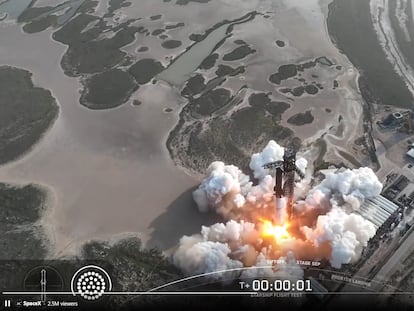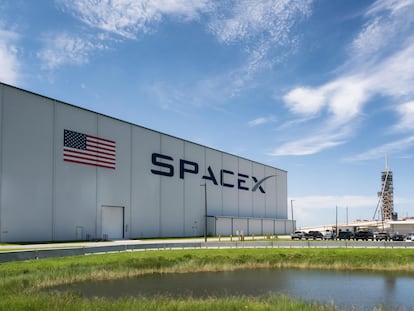SpaceX's Starship explodes on Earth, generating a huge fireball.

The Starship SpaceX has everyone accustomed to what is euphemistically called an “unscheduled rapid disassembly” – that is, exploding . But these accidents usually occur after launch. At 11 p.m. in Texas (6 a.m. in mainland Spain), Elon Musk’s company’s spacecraft exploded on the ground during a static fire test of the upper stage of the mega-rocket – the ship, called Ship. It is the same element that has blown to pieces in the last three test flights of the largest space shuttle ever built.
An hour and a half after the explosion, SpaceX posted a statement on the X network explaining that the rocket “experienced a significant anomaly” while being prepared at the base for the tenth flight. “Throughout the operation, a safety clear zone was maintained around the site and all personnel are safe and sound,” the tweet said. In addition, Musk’s company assured that its team “is actively working to secure the test site and the immediate surrounding area in collaboration with local authorities.” Finally, it added that “there is no danger to residents of the surrounding communities,” and called on the public to not attempt to approach the area while security operations continue.
On Wednesday, June 18 at approximately 11 pm CT, the Starship preparing for the tenth flight test experienced a major anomaly while on a test stand at Starbase. A safety clear area around the site was maintained throughout the operation and all personnel are safe and accounted…
— SpaceX (@SpaceX) June 19, 2025
According to local media citing authorities, no injuries have been reported, but Brownsville Fire Department crews were called to the space station to put out the fire.
It was a routine fueling and ignition test, in preparation for the spacecraft's tenth flight test, the date of which had not yet been announced. The purpose of these static fire tests is to verify the functioning of the entire system. The test is static because the rocket remains stationary during combustion. During the test, the performance of the engines, thrust capacity, and the functionality of other key systems can be verified. However, shortly after the engines were ignited, the spacecraft exploded, causing a massive fireball at Starbase, which is both SpaceX's base and the newly established Texas municipality where it is located .
According to the broadcast of the test being conducted by the specialized website NSF, the explosion occurred at 11:01:52 AM Texas time, almost 6:02 AM in mainland Spain. The accident represents a serious setback for SpaceX due to the damage caused to the base. After the initial explosion, smaller ones followed, and a massive fire continued an hour after the incident.
The Starship managed to reach space at the end of May, before exploding for the third time in a row. It did not do so, as in the two previous tests, over the Atlantic Ocean , but much later over the Indian Ocean. In fact, it took off successfully. Afterwards, SpaceX announced that it had lost control of the aircraft. The company communicated what this meant: the rocket would not return to Earth, as planned.
Wednesday's test was the second static ignition test in preparation for the rocket's tenth flight test. SpaceX considered the ninth flight test to mark an important milestone in returning Starship to space. The company announced it would review the data and implement further improvements in preparation for the next Starship and Super Heavy for flight. "Developmental testing, by definition, is unpredictable, but every lesson learned advances Starship's goal of making life on other planets possible," the company concluded optimistically on that occasion.
Do you want to add another user to your subscription?
If you continue reading on this device, it will not be possible to read it on the other device.
ArrowIf you want to share your account, upgrade to Premium, so you can add another user. Each user will log in with their own email address, allowing you to personalize your experience with EL PAÍS.
Do you have a business subscription? Click here to purchase more accounts.
If you don't know who's using your account, we recommend changing your password here.
If you decide to continue sharing your account, this message will be displayed indefinitely on your device and the device of the other person using your account, affecting your reading experience. You can view the terms and conditions of the digital subscription here.

Chief correspondent for EL PAÍS in the United States. He developed his career at EL PAÍS, where he served as editor-in-chief of the Economy and Business section, deputy editor, and assistant editor, and at the financial daily Cinco Días, where he served as editor.
EL PAÍS






